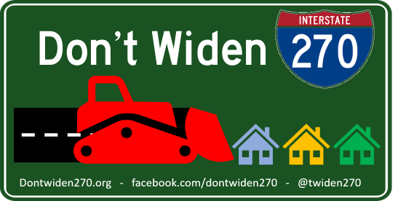Background:
Governor Hogan and the Maryland Department of Transportation (MDOT) are pushing through the Governor’s plan to use private financing to add toll lanes to I-270 and I-495. If the $11 billion (or more) project goes through, it will be the largest public-private partnership (P3) project in North America, binding the state, taxpayers, and private companies together for a term of 50 years.
The plan has major flaws that make it more likely to be a costly boondoggle than an effective traffic solution. Citizens need to understand the problems with the plan and ask hard questions about the project and its effectiveness, cost to taxpayers and impact on Maryland’s fiscal health, and climate and environmental impacts.
Does Widening Provide Long-term Congestion Relief?
It has been well-documented around the country that widening highways doesn’t actually relieve congestion. It may seem logical that adding more lanes would reduce traffic, but what actually happens is that additional lanes attract more drivers, and traffic builds up again. We’ve seen this before – traffic engineers promised when I-270 was widened in 1990 that the doubling of lanes would relieve traffic until at least 2010. But by 1999, the highway had been reduced to a “rolling parking lot,” according to the Washington Post (1), and one commuter noted that the road had started clogging up again five years after widening. Traffic will fill empty space. It’s called induced demand. More roads lead to more driving – with no reduction in congestion.
How About Tolls?
Virginia introduced tolls on I-66 in 2017 to reduce congestion and speed traffic times, but it hasn’t worked out very well. As the Post reported in 2018, “The state’s promise — less congestion and faster travel times during rush hour — has been fulfilled for many commuters able to pay or carpool, but the new toll system has had an adverse effect for many of the remaining road users. For some commuters, the rush-hour period has simply shifted later — outside the toll hours — and dumped them onto an interstate just as gridlocked as before.” (2)
The managed tolls in Virginia have frequently exceeded $40 for a single trip. Prices could be similar on I-270 - the Maryland Transit Opportunities Coalition estimates that tolls from Frederick to Shady Grove could be as high as $41 at rush hour. And if you can’t afford the tolls, you’ll be in the general-purpose lanes – which need to remain congested enough to convince others to pay for the toll lanes.
The project isn’t free to taxpayers – or Maryland’s fiscal health
Privately financed highway projects are risky. According to a December 2016 study by the U.S. Department of Transportation, “During the past decade, many U.S. highway public-private partnerships (P3s) have experienced financial distress due to lower-than-expected traffic and revenue.” (3) The study identified three projects in Virginia (the Dulles Greenway, I-495, and the Pocahontas Parkway), among others around the country, that had to be re-negotiated because the finances were not working out.
Governor Hogan has repeatedly said the project won’t cost the taxpayers anything. As reported by the Washington Post (April 11, 2019), “He has said the lanes, which are estimated to cost $9 billion to $11 billion, would cost the state nothing because the private partner would finance their construction and build and operate them in exchange for keeping the toll revenue.” But we are already seeing this isn’t true. For example, the Governor is seeking approval to spend $90 million of taxpayer dollars to hire contractors to work on the project.
More investment in cars = more carbon pollution = more global warming
The plan’s nearly complete focus on cars would increase the carbon pollution that contributes to global warming and other pollutants that directly and indirectly contribute to premature mortality and respiratory ailments. Maryland law commits the state to reduce its carbon pollution by 40% by 2030, but planning for this project ignores that goal.
The plan leaves low-income people behind. By excluding transit options, the state plan does nothing to expand the options for lower-income people to get to work and home. Want a transit alternative to I-270? It’s not in the plan. And drivers who don’t want to pay the tolls will be stuck in the same congestion as before.
There are better approaches
None of the State’s final alternatives include mass transit despite public support for that option. Mass transit alternatives used in conjunction with existing highways could lessen traffic, better serve low-income residents, and result in far less pollution. We should be investing in other regional transit mechanisms such as efficient bus rapid transit, commuter rail, and other 21st century transit innovations - some local business leaders are making a case for building a monorail system.
What you can do
Your involvement is important. Here’s how you can get started:
Stay informed. Since its inception in August 2018, DontWiden270.org’s volunteers have educated thousands of community residents about the state’s plans, organized citizen meetings with local elected officials and state legislators, and played an active role at public meetings and hearings. Sign up at https://dontwiden270.org.
Keep in touch with your elected officials. Make sure you’ve let each of them know how you feel about the project. Googling “Who Represents Me” plus the word “city”, “county” or “state legislature” should get you to websites that can tell you who represents you and how to reach them.
Washington Post, “MD’s Lesson: Widen the Roads, Drivers Will Come”, 01/04/99. https://wapo.st/2w4WNpK.Washington Post, “Year-old 66 Express Lanes have caused shifts in commuter behavior, but not necessarily in ways officials hoped”, 12/08/18. https://wapo.st/2HnExhv.U.S. Department of Transportation, “Report on Highway Public-Private Partnership Concessions in the United States”, December 2016. https://bit.ly/2E7wTWA.
